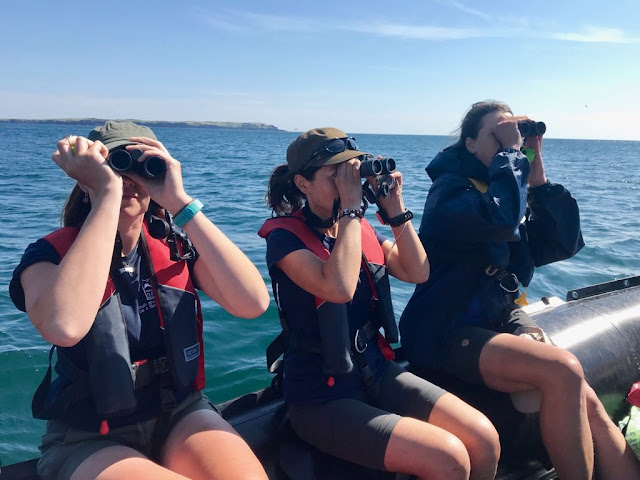I am on Skomer for three weeks now. June is the busiest month on the island with visitors and breeding birds. As Seabird Volunteer I am an extra help for the main breeding season.
My name is Magdalena (Magda). I am from the northern part of Germany and currently studying Biology at the University of Hamburg. For my master’s thesis I analyse the foraging behaviour of two different wader species in the Wadden Sea: the Dunlin and the Red Knot.
I always wanted to go to an Island for a longer period to get inside on what is required to keep a place like Skomer running. Normally you must stay for at least three months. Being on Skomer as the Seabird Volunteer is a nice opportunity for me to live on an Island for five weeks, to learn more about monitoring birds and to get experience in practical conservation.
 |
South Haven: Bluebells and Red
Campion on South Plateau
|
When I first arrived on Skomer the Bluebells and the Red Campion were forming a blue pinkish carpet on the whole Island. Many butterflies and moths can be found and, of course, there are the birds!I am involved in everything which is connected to the whole island seabird counts - including counts from a boat, counts from land, the Manx Shearwater census and data entry. But of course, there are more things were help is needed e.g. chicks of many bird species get ringed.
 |
Seabird boat counts with perfect
weather
|
The Manx Shearwater census has a special addition this year. Apart from the annual census there is a whole island census, which recently came to an end. The whole island census had about 300 plots and there were six people who spend one to three weeks on the Island only for the census. In total they invested about 500 men hours crawling over the Island in all weathers.
How does the Manx Shearwater census work?
For the annual census there are 18 plots which we use each year. To find them they are marked with a metal cane and a GPS point. We use 25 m ropes. With the first rope we mark North and each person uses one rope to walk from the cane outwards forming many pie-like pieces.
We work clock wise and, using MP3-players, we play a territorial call of the Manx Shearwater for 10 seconds down every burrow, waiting another 10 seconds for the bird to respond. We use two different clickers - one for a positive response and another one for a negative response. As for burrows, we only count those which have a real breeding chamber and are not only a tunnel. We must make sure that we count burrows with two entrances only as one. Another difficulty is a double response. When there are two birds calling you must find out whether there are two burrows or two birds in one burrow.
We work clock wise and, using MP3-players, we play a territorial call of the Manx Shearwater for 10 seconds down every burrow, waiting another 10 seconds for the bird to respond. We use two different clickers - one for a positive response and another one for a negative response. As for burrows, we only count those which have a real breeding chamber and are not only a tunnel. We must make sure that we count burrows with two entrances only as one. Another difficulty is a double response. When there are two birds calling you must find out whether there are two burrows or two birds in one burrow.
Having finished all 18 plots it’s no surprise that some of us can mimic a Manxie call almost perfectly. Or is it because my “hutmate” Dulcie and I hear them all day AND all night...?
 |
Doing the Shearwater Plots
everyone searches their “slice” for burrows
|
 |
Keeping the motivation up, even
when getting soaked
|
Our evening hobby is
Oystercatcher ringing. There are many Oystercatcher breeding pairs on the
Island, which all have chicks in a ring-able or almost ring-able age by now.
The chicks must be big enough so that the rings don’t go off and if they are to
big they might be able to fly and impossible to catch. That’s why the age of
one to two weeks is perfect for ringing. But it is very difficult to find them.
As soon as they hatch they are relatively mobile and hide under high
vegetation. When we see a bird, we must be very fast, if we are to slow they
will run and hide otherwise they will crouch. And then we must find the
perfectly camouflaged chick, which is impossible if we haven’t seen were it
went. Until today we managed to find six of them. All have got new shiny orange
and metal bracelets.
 |
Oystercatcher chick with his new
rings
|
There are only two weeks left until I will return to Germany. I am
looking forward to the rest of my stay.
Magdalena Behrens (Seabird Volunteer)











